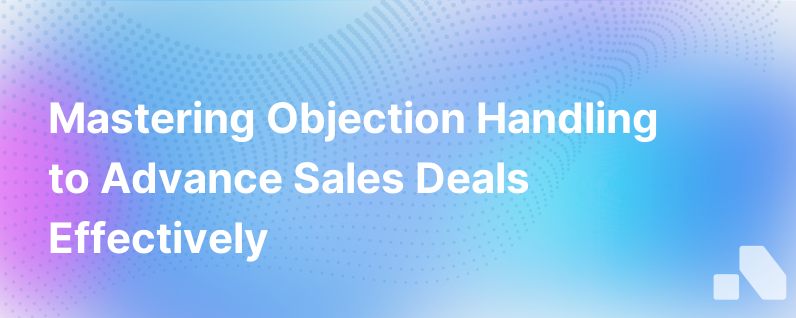
In the complex tapestry of sales, objection handling is akin to a masterful dance; it requires poise, anticipation, and a thorough understanding of your partner's next move. This delicate art form is one of the cornerstones of a successful sales strategy, as objections are inevitable and often signal a prospect’s engagement and interest in the dialogue.
As sales professionals know, an objection is not the end of a conversation; instead, it’s a pivotal point that can lead to deeper understanding and, ultimately, move a deal forward. In this in-depth examination, we will unearth the tools and techniques that transcend mere rebuttals, transform objections into assets, and help in artfully guiding a deal to closure.
Understanding the Nature of Objections
Before diving into handling techniques, it's vital to comprehend the nuances of objections. They are often rooted in:
- Uncertainty: The prospect might not have a clear understanding of your product or its relevance to their specific needs.
- Inertia: Change can be daunting. Prospects might be resistant to altering their status quo.
- Skepticism: Trust must be earned, and prospects might be wary due to past experiences or perceived risks.
- Constraints: Budgetary, operational, or other logistical constraints can lead to objections regarding the feasibility of the acquisition or implementation of a solution.
Recognizing these underpinnings permits a more empathetic and strategic approach to objection handling.
Cultivating the Skills for Handling Objections
Mastering objection handling requires a skill set that balances psychological insight with practical prowess.
- Active listening: Truly hearing the prospect's concerns helps unpack the real issues behind the objection.
- Empathy: Understanding the prospect's perspective builds rapport and trust.
- Clarity: Clear communication ensures that your explanation or solution is readily understood.
- Resilience: Maintaining positivity and persistence without being pushy is key to moving the conversation forward.
And now, let's delve into the tactical aspects of objection handling.
Techniques for Handling Objections
1. Acknowledge and Isolate
When faced with an objection, acknowledge it without immediate refutation. Instead, try to isolate the concern to understand if it's the only obstacle. For example:
“I understand that cost is a significant concern for you. Apart from the price, does our solution meet your needs?”
This technique not only validates the prospect's concerns but also allows you to address specific objections without getting sidetracked.
2. Reframe and Pivot
Objections often arise from a lack of perspective on the prospect's part. Utilizing the art of reframing can reposition the objection as a benefit or an opportunity:
“While our initial investment is higher, our customers actually see a reduction in total cost of ownership over time due to the efficiency gains and reduced maintenance expenses.”
3. Provide Evidence
Sometimes, the most effective way to counteract skepticism is by presenting concrete proof. Case studies, testimonials, or data can be persuasive:
“It’s great that you’re focusing on results. Our client, Company X, saw a 20% increase in productivity within the first quarter of implementation. Would you like to see the case study?”
4. Clarify and Educate
Occasionally, objections are based on misinformation or a misunderstanding about your product or service. Politely clarifying the misinformation can remove the objection:
“There seems to be a misunderstanding regarding the implementation process. May I walk you through it so we can address any specific concerns you might have?”
5. Explore Compromise
When objections are based on constraints, empathetically exploring compromise can propel the negotiation. Offer alternatives or phased solutions:
“If investing in the full suite is beyond current budget constraints, we could start with a scaled-down version or a pilot program to prove value.”
6. Utilize the 'Feel, Felt, Found' Method
This method creates a sense of community around an objection by illustrating that others have felt similarly and have found a solution by moving forward:
“I understand how you feel. Several of our clients have felt the same way initially. What they found was that our integration process is less time-consuming than anticipated due to our dedicated support.”
7. Leverage Technology
Leveraging sales enablement tools like Aomni ensures that your sales representatives have quick access to updated resources such as whitepapers, pricing comparisons, and ROI calculators which they can use to handle objections on the fly.
Handling Objections is a Conversation, Not a Challenge
Transform objections into conversations by engaging with the prospect's concerns as a consultant rather than a salesperson. This shift in perspective is pivotal in creating a non-confrontational atmosphere where collaboration can thrive.
The Boomerang Technique
This technique involves turning an objection back into a reason to buy. It should be used sparingly, and only when you fully understand the prospect's issue:
“It's precisely because you are concerned about scalability that our modular solution is ideal for you. It's designed to grow with your business, so you're never paying for what you don't need.”
Use Questions Effectively
Questions can guide prospects to their own conclusions and diffuse objections before they’re even raised:
“Considering your goal to increase productivity, how valuable would it be if implementation time were halved?”
In conclusion, objection handling in sales is less about overcoming hurdles and more about escorting prospects through a journey of understanding and insight. It’s important to employ active listening, empathize with prospects, and use proven techniques and technology to address concerns effectively.
Remember, each objection is an opportunity for dialogue and deeper engagement. When addressed adeptly, objections transform from roadblocks into stepping stones, guiding the way to successful deal closure.